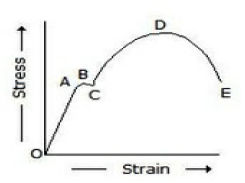Select the correct statement as per Charles' law
p.v = constant, if T is kept constant
v/T = constant, if p is kept constant
p/T = constant, if v is kept constant
T/p = constant, if v is kept constant
Correct Answer :
B. v/T = constant, if p is kept constant
Related Questions
One kg of carbon produces __________ kg of carbon dioxide.
3/7
7/3
11/3
3/11
When it is indicated that a member is elastic, it means that when force is applied, it will
Not deform
Be safest
Stretch
Not stretch
When a body is subjected to biaxial stress i.e. direct stresses (σx) and (σy) in two mutually perpendicular planes accompanied by a simple shear stress (τxy), then maximum normal stress is
(σx + σy)/2 + (1/2) × √[(σx - σy)² + 4 τ²xy]
(σx + σy)/2 - (1/2) × √[(σx - σy)² + 4 τ²xy]
(σx - σy)/2 + (1/2) × √[(σx + σy)² + 4 τ²xy]
(σx - σy)/2 - (1/2) × √[(σx + σy)² + 4 τ²xy]
The molecular mass expressed in gram (i.e. 1 g - mole) of all gases, at N. T. P., occupies a volume of
0.224 litres
2.24 litres
22.4 litres
224 litres
The efficiency of Diesel cycle with decrease in cut-off
Increases
Decreases
First increases and then decreases
First decreases and then increases
When two plates are butt together and riveted with cover plates with two rows of rivets, the joint is known as
Lap joint
Butt joint
Single riveted single cover butt joint
Double riveted double cover butt joint
A continuous beam is one which is
Fixed at both ends
Fixed at one end and free at the other end
Supported on more than two supports
Extending beyond the supports
The relation between Young's modulus (E), shear modulus (C) and bulk modulus (K) is given by
E = 3K.C/(3K + C)
E = 6K.C/(3K + C)
E = 9K.C/(3K + C)
E = 12K.C/(3K + C)
Which is the incorrect statement about Carnot cycle?
It is used as the alternate standard of comparison of all heat engines.
All the heat engines are based on Carnot cycle.
It provides concept of maximising work output between the two temperature limits.
All of the above
The heat and work are mutually convertible. This statement is called __________ law of thermodynamics.
Zeroth
First
Second
Third
Which of the following is correct?
Gauge pressure = Absolute pressure + Atmospheric pressure
Absolute pressure = Gauge pressure + Atmospheric pressure
Absolute pressure = Gauge pressure - Atmospheric pressure
Atmospheric pressure = Absolute pressure + Gauge pressure
When the gas is cooled at constant pressure,
Its temperature increases but volume decreases
Its volume increases but temperature decreases
Both temperature and volume increases
Both temperature and volume decreases
The absolute zero temperature is taken as
237°C
-273°C
-237°C
273°C
The behaviour of a perfect gas, undergoing any change in the variables which control physical properties, is governed by
Boyle's law
Charles' law
Gay-Lussac law
All of these
Proof resilience per material is known as
Resilience
Proof resilience
Modulus of resilience
Toughness
In a reversible adiabatic process, the ratio of T1/T2 is equal to
(p2/p1)γ - 1/ γ
(p1/p2)γ - 1/ γ
(v2/v1)γ - 1/ γ
(v1/v2)γ - 1/ γ
The compression ratio for petrol engines is
3 to 6
5 to 8
10 to 20
15 to 30
A cantilever beam is one which is
Fixed at both ends
Fixed at one end and free at the other end
Supported at its ends
Supported on more than two supports
In order to know whether a column is long or short, we must know its
Ultimate shear stress of the column
Factor of safety
Torque resisting capacity
Slenderness ratio
One kg of carbon requires 4/3 kg of oxygen and produces __________ kg of carbon monoxide gas.
8/3
11/3
11/7
7/3
The following cycle is used for air craft refrigeration
Brayton cycle
Joule cycle
Carnot cycle
Reversed Brayton cycle
The general gas energy equation is (where Q1 - 2 = Heat supplied, dU = Change in internal energy, and W1 - 2 = Work done in heat units)
Q1 - 2 = dU + W1 - 2
Q1 - 2 = dU - W1 - 2
Q1 - 2 = dU/W1 - 2
Q1 - 2 = dU × W1 - 2
The bending moment at a point on a beam is the algebraic ________ of all the moments on either side of the point.
Sum
Difference
Multiplication
None of the above
In the below figure, the plastic range occurs

Before point A
Beyond point A
Between points A and D
Between points D and E
The total energy of a molecule is shared equally by the various degrees of freedom possessed by it. This law is known as
Law of equipartition of energy
Law of conservation of energy
Law of degradation of energy
None of these
A body is subjected to a direct tensile stress of 300 MPa in one plane accompanied by a simple shear stress of 200 MPa. The maximum shear stress will be
-100 MPa
250 MPa
300 MPa
400 MPa
The layer at the centre of gravity of the beam as shown in the below figure, will be

In tension
In compression
Neither in tension nor in compression
None of these
The cycle in which heat is supplied at constant volume and rejected at constant pressure is known as
Dual combustion cycle
Diesel cycle
Atkinson cycle
Rankine cycle
The fuel mostly used in steam boilers is
Brown coal
Peat
Coking bituminous coal
Non-coking bituminous coal
The strain energy stored in a solid circular shaft in torsion, subjected to shear stress (τ), is: (Where, G = Modulus of rigidity for the shaft material)
τ²/ 2G × Volume of shaft
τ/ 2G × Volume of shaft
τ²/ 4G × Volume of shaft
τ/ 4G × Volume of shaft
